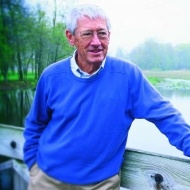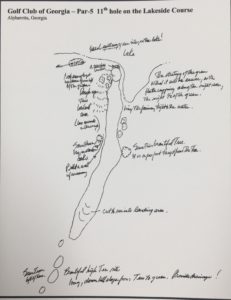Arthur Hills, a past president of the American Society of Golf Course Architects (ASGCA), has over forty years experience in  designing and restoring golf courses for real estate development communities, private clubs, resorts, and upscale public golf facilities. His Toledo, Ohio-based firm has designed more than 180 new courses in the United States, Europe, and Asia, including Half Moon Bay, Bay Harbor, Quinta da Marinha Oitavos Golfe, Big Horn Golf Club, the Arthur Hills Course at Palmetto Hall, Shepherd’s Hollow, The Club at Iron Bridge, Bonita Bay, LPGA International, The Golf Club of Georgia, Egypt Valley, Longaberger Golf Club, Hyatt Regency Hill Country, and TPC at Eagle Trace. They have also renovated more than 120 courses including renowned clubs like Oakmont, Crystal Downs, Congressional Country Club, Oakmont, Inverness, and Oakland Hills.
designing and restoring golf courses for real estate development communities, private clubs, resorts, and upscale public golf facilities. His Toledo, Ohio-based firm has designed more than 180 new courses in the United States, Europe, and Asia, including Half Moon Bay, Bay Harbor, Quinta da Marinha Oitavos Golfe, Big Horn Golf Club, the Arthur Hills Course at Palmetto Hall, Shepherd’s Hollow, The Club at Iron Bridge, Bonita Bay, LPGA International, The Golf Club of Georgia, Egypt Valley, Longaberger Golf Club, Hyatt Regency Hill Country, and TPC at Eagle Trace. They have also renovated more than 120 courses including renowned clubs like Oakmont, Crystal Downs, Congressional Country Club, Oakmont, Inverness, and Oakland Hills.
As a kid, my father took me to the Toledo Open and I got to see the great Walter Hagen up close and shake his hand. He was impressive!
I went home and created a three-hole course around our farmhouse, mowing down “fairways” and “greens” with a push lawnmower, over and over, until I got the ground flat enough so my friends and I could putt on it. I guess that was technically my first course.
But after college, by 1966, I was a successful landscape architect with five children. One day I placed an ad in the yellow pages proclaiming myself a golf course architect. That is how I joined the ranks.
There were very few golf architects at the time, so, believe it or not, my phone rang and I got a job building a simple nine-hole course on a farm on the outskirts of Toledo.
One of my most high-profile, and most challenging design jobs was the Legends Course at LPGA International near Daytona Beach, Florida, not far from the famous speedway, at the world headquarters of the LPGA. The land had teeming wetlands and very dramatic stands of pine trees and most of the site was covered with dense palmetto, so thick that when we went out to walk the site, we couldn’t see through the stuff. It forced us to hack centerlines with machetes– three-foot wide slots down the center of each “hole.” Drew Rogers and Mike Dasher from our staff had one heck of a time trying to mark the clearing limits (the limits that define the far right and far left edges of the holes for the construction teams to clear to). Since they could not get a measuring tape through the vegetation, they would pace their way outward from the centerlines through the thick growth, never knowing when they would step in a hole or on a snake, until they counted off enough steps.
Beach, Florida, not far from the famous speedway, at the world headquarters of the LPGA. The land had teeming wetlands and very dramatic stands of pine trees and most of the site was covered with dense palmetto, so thick that when we went out to walk the site, we couldn’t see through the stuff. It forced us to hack centerlines with machetes– three-foot wide slots down the center of each “hole.” Drew Rogers and Mike Dasher from our staff had one heck of a time trying to mark the clearing limits (the limits that define the far right and far left edges of the holes for the construction teams to clear to). Since they could not get a measuring tape through the vegetation, they would pace their way outward from the centerlines through the thick growth, never knowing when they would step in a hole or on a snake, until they counted off enough steps.
When they each reached their respective edge, they couldn’t see each other, so they had to throw marking tape up in the air to find each other and line up properly!
They faced mosquitoes, bugs, armadillos, water moccasins, rattlesnakes and wild boar in developing the course with LPGA players Meg Mallon and Beth Daniel. The ladies had interesting viewpoints on the holes, and I taught them one of my secrets of golf course architecture: design golf holes backwards – from the green to the tee; not the tee to the green. Turn around sometime when you’re playing a hole and look back from the green. You’ll spy a brand new view of how to create a golf hole.
Max Szturm, the deceased superintendent at Wildwood Country Club in Middletown, OH, and I, for years, played golf together for modest stakes at superintendents’ meetings in southwest Ohio. One time we came to the ninth hole, a par-3, at Piqua Country Club. Max was a very good player. I teed up, hit my tee shot 12-feet from the hole and said to Max, “Max beat that if you can.” Max then took the my breath away – and the wind out of my sales – when he hit his shot into the hole!

